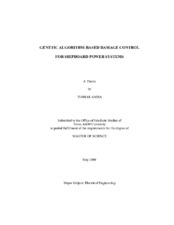| dc.contributor.advisor | Butler-Purry, Karen L. | |
| dc.creator | Amba, Tushar | |
| dc.date.accessioned | 2010-07-15T00:11:09Z | |
| dc.date.accessioned | 2010-07-23T21:42:52Z | |
| dc.date.available | 2010-07-15T00:11:09Z | |
| dc.date.available | 2010-07-23T21:42:52Z | |
| dc.date.created | 2009-05 | |
| dc.date.issued | 2010-07-14 | |
| dc.date.submitted | May 2009 | |
| dc.identifier.uri | https://hdl.handle.net/1969.1/ETD-TAMU-2009-05-282 | |
| dc.description.abstract | The work presented in this thesis was concerned with the implementation of a
damage control method for U.S. Navy shipboard power systems (SPS). In recent years,
the Navy has been seeking an automated damage control and power system management
approach for future reconfigurable shipboard power systems. The methodology should
be capable of representing the dynamic performance (differential algebraic description),
the steady state performance (algebraic description), and the system reconfiguration
routines (discrete events) in one comprehensive tool. The damage control approach
should also be able to improve survivability, reliability, and security, as well as reduce
manning through the automation of the reconfiguration of the SPS network.
To this end, this work implemented a damage control method for a notional Next
Generation Integrated Power System. This thesis presents a static implementation of a
dynamic formulation of a new damage control method at the DC zonal Integrated Flight
Through Power system level. The proposed method used a constrained binary genetic
algorithm to find an optimal network configuration. An optimal network configuration is
a configuration which restores all of the de-energized loads that are possible to be restored based on the priority of the load without violating the system operating
constraints. System operating limits act as constraints in the static damage control
implementation. Off-line studies were conducted using an example power system
modeled in PSCAD, an electromagnetic time domain transient simulation environment
and study tool, to evaluate the effectiveness of the damage control method in restoring
the power system. The simulation results for case studies showed that, in approximately
93% of the cases, the proposed damage algorithm was able to find the optimal network
configuration that restores the power system network without violating the power system
operating constraints. | en |
| dc.format.mimetype | application/pdf | |
| dc.language.iso | eng | |
| dc.subject | Damage control | en |
| dc.subject | genetic algorithm | en |
| dc.subject | integrated power system | en |
| dc.subject | integrated fight through power | en |
| dc.subject | optimization | en |
| dc.subject | power system dynamics | en |
| dc.subject | power system restoration | en |
| dc.subject | shipboard power system | en |
| dc.title | Genetic Algorithm Based Damage Control For Shipboard Power Systems | en |
| dc.type | Book | en |
| dc.type | Thesis | en |
| thesis.degree.department | Electrical and Computer Engineering | en |
| thesis.degree.discipline | Electrical Engineering | en |
| thesis.degree.grantor | Texas A&M University | en |
| thesis.degree.name | Master of Science | en |
| thesis.degree.level | Masters | en |
| dc.contributor.committeeMember | Singh, Chanan | |
| dc.contributor.committeeMember | Bhattacharyya, Shankar | |
| dc.contributor.committeeMember | Butenko, Sergiy | |
| dc.type.genre | Electronic Thesis | en |
| dc.type.material | text | en |


